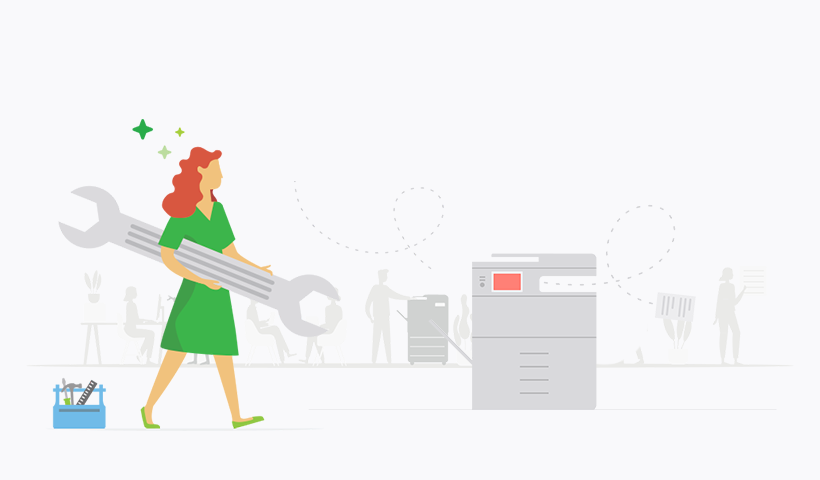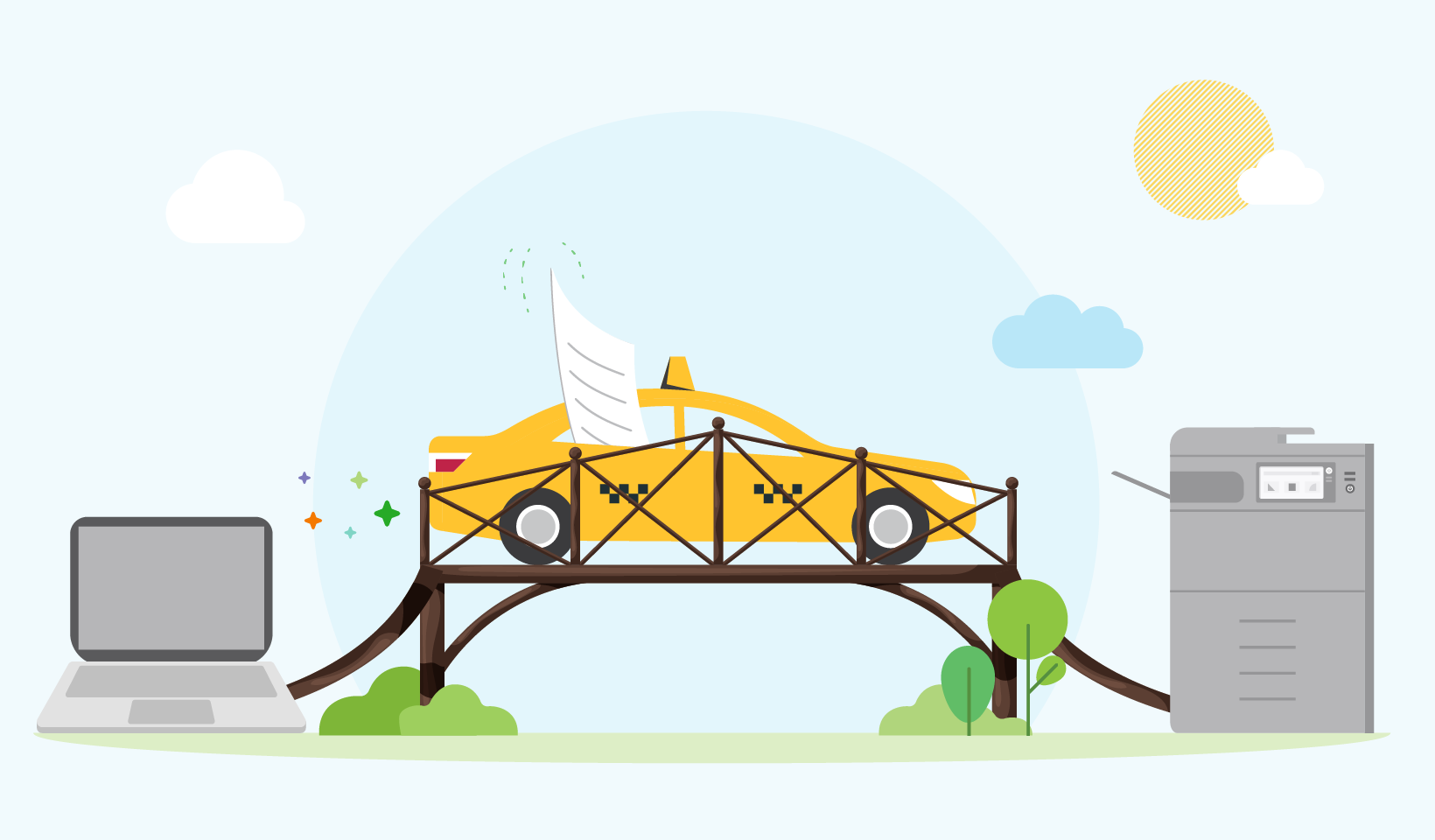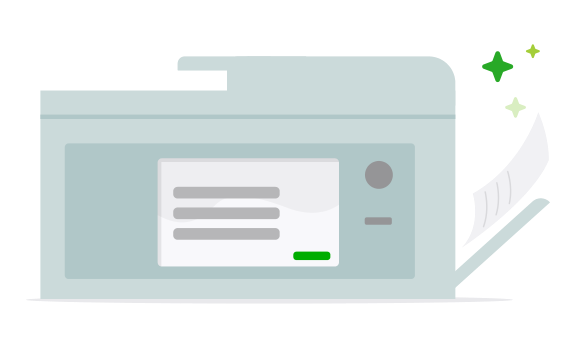Look at your printer. Now look at your computer. Now imagine a bridge between your printer and your computer.
Now picture this: Your print job wants to travel from your computer to the printer. To make that journey, it needs to jump in a car. That car will transport your digital file from your computer to your printer.
Now, imagine that the passenger speaks the native language of your computer. To prepare itself for its arrival at the printer, it needs a driver who will understand them and translate what they’re saying into a language that the printer can understand.
Okay, that analogy fell down a little, but that car and the person behind the wheel that transports the passenger from Place A to Place B, that’s essentially what a print driver is and does.
Print drivers bridge your computer to your printer, facilitating the communication necessary to convert digital documents into physical printouts.
What is a print driver and what does it do?
A print driver (sometimes known as a print processor) is a software component that enables your computer to communicate with your printer. It’s a print job interpreter, translating the computer’s digital data into a recognizable format the printer can understand.
What does it translate? Every individual element of the print job. That’s page layout, paper type, print quality settings, and more. The print driver intimately knows your printer’s capabilities. Its job is to ensure the accurate production of your digital file into a piece of paper with all the squiggly lines and other bits and pieces in the right place on the page.
Essentially, the print driver allows you to press print within an application, and your computer doesn’t need to worry about the technical specifications of your printer. The print driver takes care of that. Its primary function is to facilitate the printing process by converting the print job’s electronic data into a language the printer can interpret and spit out as a physical copy. My taxi driver translator analogy makes sense now, right? Each operating system is a different language, so each OS might need a different driver to talk to the printer.
The purpose of the print driver is to provide a seamless interface between your computer’s operating system and the printer. This is especially relevant for printers with unique finishing options like stapling, booklet making, hole punching, etcetera. The print driver enables you to select those different print options, as well as preview documents, and manage print queues.
Types of print drivers
There are two common categories of print drivers: Printer Control Language (PCL) and PostScript (PS).
PCL (Printer Control Language)
The PCL printer driver is a form of page description language (PDL) developed by Hewlett-Packard (HP) in the early 1980s. It’s a device-dependent driver, meaning it needs the printer to help with some of the translating for specific print data like underlines or fonts. PCL’s commonly used for printing text documents and graphics. This is because it’s supported by various operating systems and provides fast print processing in mixed fleet print environments. However, the printed output does change from device to device and it’s not supported in Macintosh environments.
PS (PostScript)
The PS printer driver is also used by a large variety of manufacturers. It’s most frequently used for publishing applications with complex graphics. It differs from PCL in a few ways. The largest discrepancy is that PS drivers are device independent, so the driver does all the translating. It doesn’t require any input from the printer to translate the data. The main advantage of PS drivers is they produce better-quality, more detailed graphical objects. Also, unlike PCL, the printed output remains identical from different print hardware manufacturers. The disadvantages are that the PS driver can produce slower print processing speeds and isn’t supported on as many platforms as PCL.
Universal print drivers vs manufacturer drivers
PCL and PS are the page description language types. You may have heard of universal and manufacturer/native drivers. Well, they can be in either PCL or PS form. Universal and manufacturer print drivers essentially mean if your PCL or PS driver is a general or specific driver for your hardware. The main difference between the two is what finishing options are supported.
Universal drivers are designed to be compatible with most (if not all) printer hardware brands. They’re ubiquitous by design, but, they can provide limited finishing options.
Manufacturer or native drivers are hardware-manufacturer-specific drivers with model-specific finishing capabilities like stapling, booklet making, hole-punching, collation, etc.
Windows: Type 3 vs Type 4 drivers
A lot of printing is done on Windows systems. A common issue we come across is navigating Windows Type 3 and Type 4 drivers. Don’t ask us why they’re different. They just are. And no, that doesn’t mean there’s a Type 1 or Type 2 for you to choose from.
The TL;DR summary of Windows Type 3 and Type 4 drivers: there are quite a few issues with Type 4 drivers , so we recommend you use Type 3 drivers. Download them directly from your printer manufacturer’s website wherever and whenever possible.
CUPS (Common UNIX Printing System): Linux and macOS
If you’re not printing on Windows, this is for you. CUPS is a platform-independent printing system for Linux and macOS that supports both PCL and PostScript languages. CUPS handles them both, so long as you have the appropriate universal or manufacturer drivers. CUPS is just the computer OS side of the coin, you’ll need to match it up with the right driver from the manufacturer of your printer.

Never miss the news!
This site is protected by reCAPTCHA and the Google Privacy Policy and Terms of Service apply.
Which print driver is best?
There is no singular “best driver” for printing. The choice depends on your printer model and your printing needs. As a rule of thumb, if you’re just printing plain text, a universal driver will suit. For specific finishing options, a manufacturer driver is more suitable. But, again, it all depends. Sometimes you’ll need to install and run a test page to ensure it’s the right driver for you. Speaking of…
How to install and set up a print driver
Print drivers can sometimes be a bit tricky, but in terms of general installation and setup tips, here are the basics you can check off…
- Download the driver: Logical first step. Get the thing. How? Visit the printer manufacturer’s website or follow the installation guide that came with your printer to download the latest version of the print driver.
- Connect the printer: Connect your printer to your client (device, computer, tablet, smartphone, etc) using a USB cable or set up a wireless connection if it’s a Wi-Fi network-compatible printer - it should be if it’s recent(ish).
- Driver installation: Run the driver installation file and follow the on-screen instructions. The installation process may differ slightly depending on your OS (Operating System).
- Printer detection: After the driver installation, the operating system should detect the printer and automatically configure the necessary settings.
- Test the printer: Print a test page to ensure the installation was successful and the printer is functioning correctly. Yes, your test page can totally be a cat picture.

How do you check print driver compatibility?
That’s the secret sauce of whether or not your printing will be painless or painful. The print driver needs to be compatible with both your printer model and your computer’s OS. Can we go back to my taxi driver analogy? It’s important that your driver be an interpreter. But if you speak English and your destination speaks Spanish, it’s not helpful if you have a Mandarin interpreter.
So you need to ensure your driver can actually bridge that language gap between your client and the printer. How do you ensure your driver is compatible? Check the website of your printer brand for the most up-to-date driver and install the latest version. Manufacturers regularly release updated drivers to enhance compatibility, improve performance, and address security vulnerabilities.
How do you update your print driver?
Nobody likes updating software. Well, giant print geeks do. And we love print geeks, we made a podcast for them! But most people find software updates obtrusive and an interruption to productivity and workflows. The two most common disruptions to a print driver working are whether or not it’s compatible with your printing device, as mentioned above, and whether or not it’s up to date.
The good news is, most operating systems offer automatic driver updates, allowing you to receive the latest print driver versions without manual intervention. Or, if you prefer to be in control of your update cycle, just make sure you check your OS notifications for software updates. And don’t snooze it for weeks at a time. Yes, I speak from experience. And, yes, I learned the hard way.
Troubleshooting print driver issues
A lot of the time, if there’s an issue with your printer, it’s often a problem with the print driver. So a good place to start is to check the compatibility and if there are any updates.
Other than that, Google is your friend. One common error message you may encounter is “print driver unavailable.” This indicates that the driver is either missing, not properly installed, or incompatible with the operating system or printer model. To resolve this issue, you can try reinstalling the driver, ensuring compatibility, or seeking assistance from the manufacturer’s support channels.
Other common print driver issues include slow printing, print spooler errors, and incorrect printouts. Troubleshooting these issues often involves checking printer connections, updating the driver, restarting the print spooler service, or adjusting print settings.
Need a print driver solution?
You’re on a print software company’s blog, I was eventually going to plug our products. PaperCut MF and PaperCut NG come with the PaperCut Global Print Driver. It’s a PostScript driver that we custom-built for maximum compatibility across different brands of printers, for when you just need every printing to work out of the box. Meanwhile, our built-for-cloud solution PaperCut Hive supports PaperCut Global Print Driver as well as manufacturer drivers.



